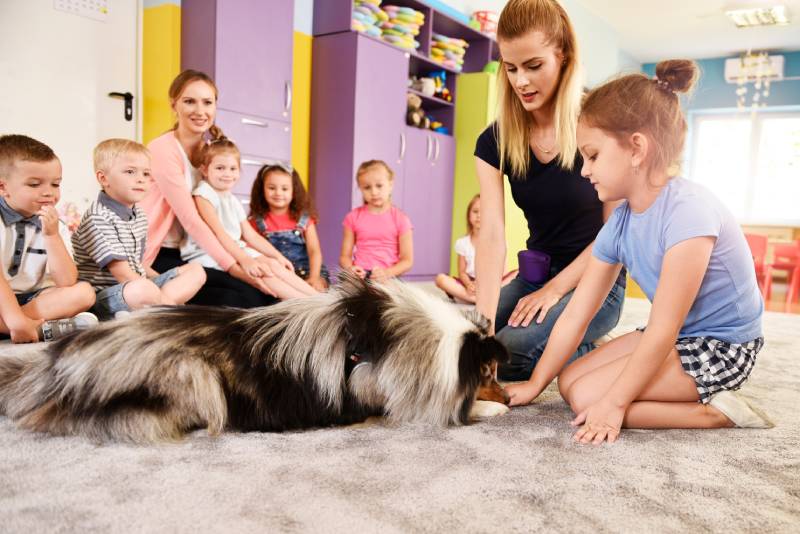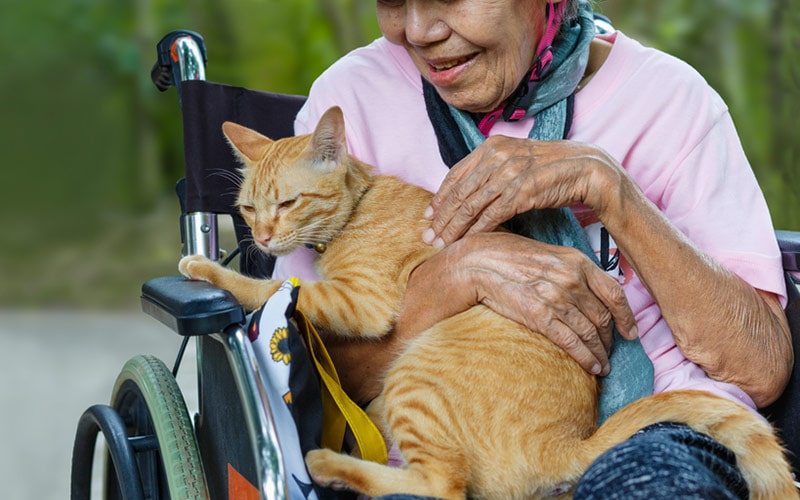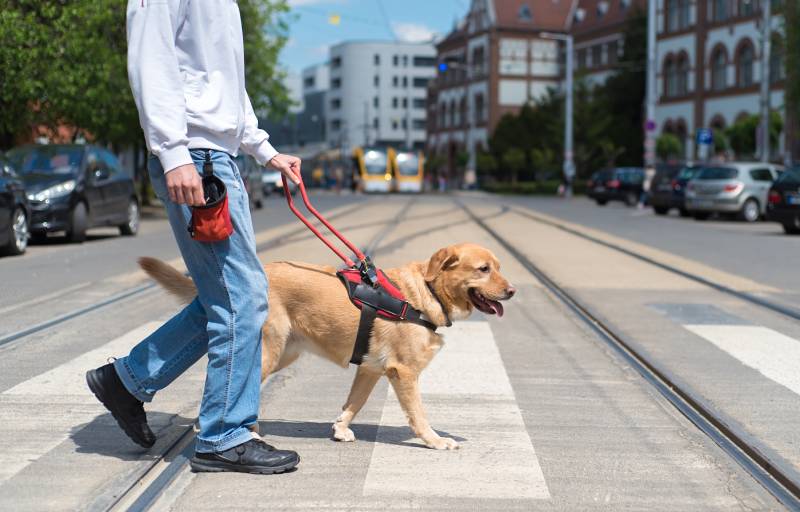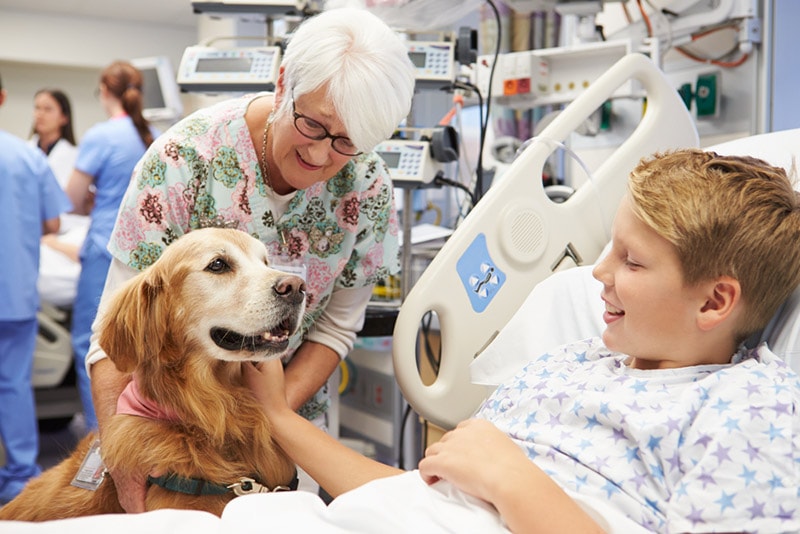VET APPROVED

The information is current and up-to-date in accordance with the latest veterinarian research.
Learn more »Click to Skip Ahead
Can you imagine a world with no animals? One can ascertain that the world would be a less compassionate and caring place with no animals, as most animals love us unconditionally. For those who live in various environments, animals can also be trained as therapy animals to provide comfort and affection.
According to the American Veterinary Medical Association (AVMA), a therapy animal can be an animal of any species that is registered with/certified by an animal-assisted intervention organization after successful training, behavioral, and veterinary evaluation. Their access to facilities where pets are prohibited is at the discretion of management, and they are not recognized by any federal law. Therapy animals can benefit those in hospitals, nursing homes, retirement homes, hospice facilities, schools, and even disaster areas by providing comfort, love, and affection. Therapy animals are not the same as emotional support animals (ESAs) or service dogs (we’ll get into the differences later), but they provide a great service, nonetheless.
Therapy animals can participate in animal-assisted interventions such as animal assisted therapy, education, and activities. The handler partners with a therapy animal, working as a team, to assist other people. However, therapy doesn’t only happen with dogs. Read on to learn about the five types of therapy animals and their amazing capabilities.

The 5 Most Common Types of Therapy Animals
1. Therapy Dogs

Therapy dogs are no doubt the most common type of therapy animal. Therapy dogs volunteer with their handlers to visit certain types of facilities, for example, to provide comfort and affection for people who are living away from home due to mental or physical illness. Therapy dogs are not specifically trained like service dogs, meaning they are not trained to perform certain tasks for disabled persons. Rather, therapy dogs are trained to be comfortable around other people and different environments.
In some situations, therapy dogs must be certified and registered through a reputable national organization before they can visit any type of facility as a therapy dog unless prior approval is obtained through the facility. The certification involves temperament assessment, training, obedience training, and more. Additionally, dogs can earn a certificate through the American Kennel Club (AKC) program by achieving the AKC Therapy Dog title.
2. Therapy Cats

Therapy cats may not pop into your mind when you think of a therapy animal, but cats can be just as effective in providing comfort, love, and affection as dogs in nursing homes, retirement homes, and other similar environments. Cats can sense negative emotions, making them ideal candidates as therapy animals to relieve stress and anxiety.
It’s important to note that therapy cats don’t necessarily need to undergo specific training. As long as the cat is comfortable giving and receiving affection from people, they can usually qualify as a therapy animal. Some cats can be aloof and prefer the pleasure of their own company, and cats with those types of temperaments, are not suited to be recognized as therapy animals.
3. Therapy Horses

You won’t see horses frolicking through nursing homes or retirement facilities like dogs, but they provide unconditional love and can reduce stress. Equine-assisted therapy can help assist those battling depression, anxiety, grief, behavioral problems, addiction, ADHD, and even eating disorders.
In equine-assisted therapy programs, professionals guide clients through activities with horses that help treat mental health. In some cases, horses may be ridden as part of occupational or physical therapy. Equine therapy is beneficial in building trust, confidence, social skills, communication, and learning boundaries, to name a few. Therapy horses can be used for a wide range of disabilities and conditions, such as Down Syndrome, brain injuries, abuse issues, Autism, dementia, and more.
4. Therapy Rabbits

Move over, Peter Cottontail, Mr. Therapy Rabbit is in town. Many people may not think of rabbits being therapy animals, but believe it or not, they can. Therapy rabbits do not necessarily need to go through a training program. Still, to be officially registered as a therapy animal, they need to meet specific qualifications, such as clean fur, trimmed nails, friendly demeanor, comfortable in any environment, well cared for, overall healthy, litter trained, and capable of wearing a leash.
In order for rabbits to be allowed into certain facilities as therapy animals, a rabbit must be registered. However, rabbits can be ideal for this purpose because they are small, don’t bark or meow, are low maintenance, and can be trained.
5. Therapy Birds

Regarding therapy birds, parrots can make excellent therapy animals because they are in tune with their environments and are empathetic toward people. Birds do not need to be certified or registered to be a therapy animal; they only require a letter from a mental health professional. Birds can help with mental and emotional stress and can help relieve anxiety, depression, post-traumatic stress disorder (PTSD), and more. A mental health professional can help guide you in choosing a bird as a therapy animal.

What’s the Difference Between Service Dogs and Therapy Dogs?
One may think these two are one and the same, but they are actually vastly different. A service dog is trained to perform specific tasks for a disabled person. According to the Americans with Disabilities Act (ADA), service dogs are allowed to enter and accompany their human inside any facility where the public is allowed, no matter if dogs are allowed or not. Service dogs are also allowed to fly in the cabin with their humans. Service dogs should pass a public access test to be allowed in public places; however, they do not need to be certified and registered in the United States.
Therapy dogs, on the other hand, are not allowed to fly with you in the cabin, and they are not trained to perform a specific task. Therapy dogs can provide comfort and affection for people dealing with stress, anxiety, depression, and other related conditions in nursing homes, retirement homes, hospitals, etc. They are also used in schools, disaster areas, and more.
What’s the Difference Between Emotional Support Animals and Therapy Animals?
Emotional Support Animals (ESAs) can be any animal species that provide therapeutic benefits to a specific person with certain needs. ESAs are not allowed in public areas where dogs are not allowed, but they are permitted inside no-pet housing facilities that do not allow dogs under the Fair Housing Act. Therapy dogs are not awarded any special rights or access to certain areas like service dogs and ESAs.

The Three Types of Therapy Animals Explained
There are three types of therapy animals, let’s break them down.
Therapeutic Visitation Animals: These therapy animals are household pets trained to visit hospitals, rehabilitation facilities, nursing homes, and other facilities to provide comfort for people living away from home due to a physical or mental illness. These animals bring much joy to people in these types of facilities and are widely used all over the country for this purpose.
Animal-Assisted Therapy Animals: These therapy animals assist occupational and physical therapists in rehab settings with the purpose of helping patients achieve their recovery goals.
Facility Therapy Animals: These animals may live in nursing homes or other assisted living facilities and are usually cared for by the facility itself. These animals assist residents living with Alzheimer’s, dementia, or other mental illnesses.

Conclusion
Therapy animals are most commonly dogs, but other animal species such as cats, horses, rabbits, and birds can also serve in this role. They provide comfort, love, and affection to individuals in nursing homes, retirement communities, and hospice facilities.
Animals are amazing, and studies prove that animals provide great emotional comfort to humans. Domesticated animals rely on humans to take care of them, and ironically, they take care of us, too, just in different ways.
- Therapy Pets | VCA Animal Hospital
- Service, emotional support, and therapy animals | American Veterinary Medical Association
- Different Types of Therapy Animals – Feinberg Consulting, Inc.
- Service, Working,Therapy, Emotional Support Dogs: Which Is Which?
- How To Train a Therapy Dog: Learning If Your Dog Is Fit For Therapy Work
- AKC Recognized Therapy Dog Organizations – American Kennel Club
- Canine Good Citizen (CGC) – American Kennel Club
- Why Therapy Cats are Just as Effective as Therapy Dogs | School of Veterinary Medicine
- What is a Therapy Cat and How Can They Help?
- Equine Therapy: Learn How Horses Help Mental and Physical Health
- What is ADHD? | CDC
- Equine Assisted Therapy – The Anxiety Treatment Center
- Therapy Birds: Emotional Support Animal? Or Merely A Pet? | BeChewy
- Can A Bird Be An Emotional Support Animal? What To Know
- Post-traumatic stress disorder (PTSD) – Symptoms and causes – Mayo Clinic
- ADA Requirements: Service Animals | ADA.gov
- Handler-Certified Public Access Test – Service Dog Certifications
- Registering a Service Dog: What You Need to Know
- Service Dog vs Therapy Dog vs Emotional Support Dogs
- Research in the use of animals as a treatment for humans | Animal Frontiers | Oxford Academic
Featured Image Credit: Monkey Business Images, Shutterstock










